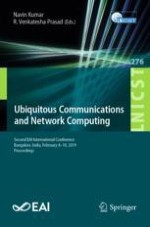2019 | Book
Ubiquitous Communications and Network Computing
Second EAI International Conference, Bangalore, India, February 8–10, 2019, Proceedings
Editors: Navin Kumar, R. Venkatesha Prasad
Publisher: Springer International Publishing
Book Series : Lecture Notes of the Institute for Computer Sciences, Social Informatics and Telecommunications Engineering
